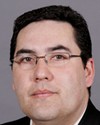Thank you, and good morning.
I would like to thank the chair and the committee members for the opportunity to speak on the subject of education this morning. I am very pleased to see that there are so many young people here today, because indeed, what this committee is considering now is of great importance to them.
INAC officials last spoke to the standing committee about first nation education in June of this year, and at that time we committed to coming back to speak to you again to provide a report on our progress to date.
Today, we will speak more specifically about post-secondary education but we would also like to take this opportunity to provide you with an update on First Nations education.
I'll start by reiterating a few key points that were made by INAC officials in June. The $1.5 billion in planned education expenditures in 2005-06 represents over 25% of total departmental expenditures. These expenditures support education programs, the majority relating to elementary and secondary instruction for first nation students ordinarily resident on reserve. As you probably know, the overwhelming majority of education programs are delivered by first nations and Inuit communities and organizations.
Since Departmental officials last appeared before the Standing Committee, we have completed our draft policy framework, with the involvement of the First Nations, that outlines rules and responsibilities of the department and of First Nations. We are now working towards a management framework that will renew and improve program delivery in all areas of First Nations education.
Post-secondary education expenditures account for about $305 million of the $1.5 billion. Within post-secondary expenditures, there are three component areas of funding.
As the first component, most of the $305 million is directed towards the post-secondary student support program, which pays for tuition, materials, and living allowances for first nation and Inuit students. This program is not residency based--that is, first nation recipients can live on or off reserve--but it requires that the recipients be status Indians or recognized Inuit.
The second component is the Indian studies support program, which provides funding to post-secondary institutions for programs and services that are specifically tailored to first nations and Inuit students. An example of this program is an aboriginal leadership and management program at Blue Quills First Nations College in Alberta, in partnership with Athabasca University. In 2004-05, program expenditures in the Indian studies support program component were approximately $20 million.
The third component is the university college entrance preparation program, which provides expenses to students for one year of preparatory course work prior to university or college administration. This program is for those who do not have high school credentials that would qualify them for admission to a post-secondary institution.
Today, almost 100% of post-secondary education students support funding is administered by First Nations and Inuit administering organizations. Unlike K/12 education, for which the Department holds a statutory responsibility, our involvement with post-secondary education is a result of a policy dating back several decades.
In 2004-05, INAC post-secondary funding supported approximately 23,000 students and over 50 post-secondary institutions.
Over time, the investment in first nations and Inuit post-secondary education has increased significantly, as have participation rates. For example, from 1976 to today, the number of students supported through post-secondary education programs has increased close to tenfold.
We know, however, that qualified applicants are currently turned down by some first nations because of a shortage of funding in the first nations post-secondary allocation in that year. Many first nations students participate in post-secondary education using other sources of funding, such as the Canada student loans program.
There are also a number of scholarships being made available from the private sector for aboriginal students. I think it's very positive that these are growing. There are also mechanisms, such as the National Aboriginal Achievement Foundation, that offer scholarships and bursaries.
The Department of Human Resources and Skills Development Canada's aboriginal human resources development strategy also makes funding available for skills training.
Despite the large increase over several decades in the number of post-secondary students supported, post-secondary attainment rates for First Nations and Inuit do not yet match those of other Canadians. According to the 2001 census, 5 per cent of Aboriginals 15 years and older have a university degree, compared to 16 per cent for the Canadian population in general.
The picture is brighter in the area of college education and trade certification. Aboriginal people have attained college diplomas and trade certification at levels comparable to the rest of the population: 27% among the total population; compared to 25% among the aboriginal population.
Indian and Northern Affairs Canada is trying to understand why post-secondary attainment rates are not comparable. A recent report by the researcher Michael Mendelson, entitled Aboriginal Peoples and Post-secondary Education in Canada, uses census data to provide a picture of the state of affairs of aboriginal peoples in post-secondary education.
His main finding is that there is a pressing need to address the very low aboriginal high school graduation rates in order to increase participation rates among first nations and Inuit in post-secondary education. He says that the main problem in the capacity of the K to 12 system is to get students into post-secondary education. The good news is that aboriginal students who graduate from high school are just as likely as students from the general Canadian population to go on to and graduate from post-secondary education.
I understand that Mr. Mendelson will be appearing before this committee next week.
As part of the Department's comprehensive review of all education programs, we committed to undertake a review of our post-secondary education program. That review has involved the participation of First Nations and Inuit organizations, and consultation with other government departments. Consultation with other stakeholders on policy options to upgrade the program is anticipated over the coming months.
Over the past year and a half, as part of their review, many diagnostic reports on post-secondary education were completed. Some of the findings of these reports are as follows.
First nations would like to see increased funding in the program to reflect increases in tuition fees and cost of living and increases in overall demand. There is also a widespread recommendation to expand the length of time allowed for the university and college entrance program from one year to two years. There's also a proposal to provide support for post-secondary education and training programs of less than one academic year.
In response to these findings and our own continuing analysis, we are developing options for a re-engineered program, including new delivery models. These options will be developed with first nations and Inuit students, educators, service providers, and organizations over the coming months.
We realize we need to do much better to ensure first nations and Inuit children and youth have the academic footing to move on to post-secondary studies and have the skills to take advantage of the merging opportunities resulting from investments in resource development projects, such as the oil sands and the Mackenzie Valley pipeline, and the retirement of baby boomers.
All parties recognize that the status quo is not accomplishing the desired results on reserve and that better coordination and a stronger education system would properly equip learners to reach their potential.
Thank you very much.




